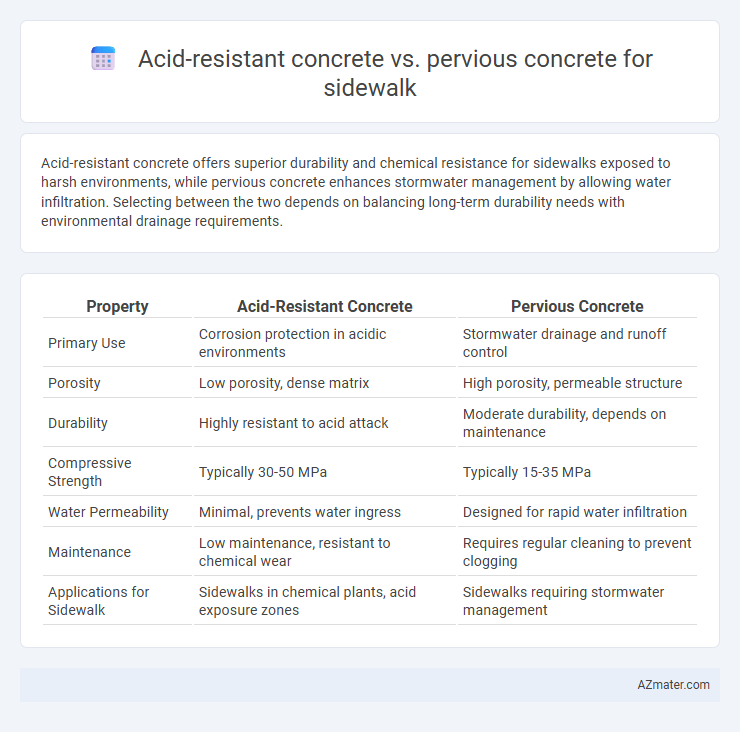Acid-resistant concrete offers superior durability and chemical resistance for sidewalks exposed to harsh environments, while pervious concrete enhances stormwater management by allowing water infiltration. Selecting between the two depends on balancing long-term durability needs with environmental drainage requirements.
Table of Comparison
| Property | Acid-Resistant Concrete | Pervious Concrete |
|---|---|---|
| Primary Use | Corrosion protection in acidic environments | Stormwater drainage and runoff control |
| Porosity | Low porosity, dense matrix | High porosity, permeable structure |
| Durability | Highly resistant to acid attack | Moderate durability, depends on maintenance |
| Compressive Strength | Typically 30-50 MPa | Typically 15-35 MPa |
| Water Permeability | Minimal, prevents water ingress | Designed for rapid water infiltration |
| Maintenance | Low maintenance, resistant to chemical wear | Requires regular cleaning to prevent clogging |
| Applications for Sidewalk | Sidewalks in chemical plants, acid exposure zones | Sidewalks requiring stormwater management |
Introduction to Specialized Concrete for Sidewalks
Acid-resistant concrete is specially formulated with chemical-resistant aggregates and binders to withstand corrosive environments, making it ideal for sidewalks exposed to industrial pollutants or acidic runoff. Pervious concrete offers exceptional permeability, allowing water to drain through and reduce surface runoff, enhancing environmental sustainability and reducing urban flooding risks. Selecting the appropriate concrete type depends on site-specific conditions, such as exposure to chemicals or the need for effective stormwater management.
Key Differences: Acid-Resistant vs Pervious Concrete
Acid-resistant concrete is specifically designed to withstand chemical corrosion from acidic substances, making it ideal for environments exposed to industrial pollutants or acid rain, whereas pervious concrete focuses on permeability to allow water drainage and reduce runoff on sidewalks. The key difference lies in their functional properties: acid-resistant concrete provides enhanced durability and surface protection against chemical attacks, while pervious concrete prioritizes environmental benefits by promoting groundwater recharge and minimizing surface water accumulation. Choosing between these depends on whether chemical resistance or water permeability is the primary requirement for sidewalk performance.
Composition and Material Properties
Acid-resistant concrete for sidewalks typically incorporates epoxy resins or specialized cementitious binders combined with aggregates like quartz or silica to enhance chemical durability against acidic environments. Pervious concrete features a high content of coarse aggregates and little to no fine aggregates, creating interconnected voids for water permeability while maintaining sufficient strength through a balanced mix of cement paste and aggregate grading. While acid-resistant concrete emphasizes chemical stability and surface integrity, pervious concrete prioritizes porosity and drainage capabilities, influencing their distinct material properties and functional performance in sidewalk applications.
Durability and Performance in Harsh Environments
Acid-resistant concrete offers superior durability in harsh environments by withstanding chemical corrosion and acidic exposure, making it ideal for industrial areas or sidewalks near chemical plants. Pervious concrete provides excellent water drainage and reduces surface runoff but may exhibit reduced durability in acidic conditions due to its porous structure. Selecting acid-resistant concrete ensures enhanced longevity and performance on sidewalks subjected to aggressive chemical impacts, while pervious concrete is better suited for environments prioritizing stormwater management over chemical resistance.
Water Management Capabilities
Acid-resistant concrete offers superior durability by preventing degradation from acidic substances, ensuring long-term structural integrity in environments exposed to chemical runoff or industrial waste. Pervious concrete excels in water management by allowing rapid infiltration of stormwater, reducing runoff and promoting groundwater recharge, making it ideal for sustainable urban drainage systems. While acid-resistant concrete provides chemical protection, pervious concrete significantly enhances water permeability and reduces surface water accumulation on sidewalks.
Chemical Resistance and Maintenance Needs
Acid-resistant concrete offers superior chemical resistance by incorporating specialized additives and coatings that prevent degradation from acidic substances, making it ideal for environments exposed to industrial chemicals or acidic rain. Pervious concrete, designed to allow water infiltration, typically has lower chemical resistance and is more susceptible to damage from acidic exposure, requiring regular maintenance to preserve its permeability and structural integrity. Maintenance needs for acid-resistant concrete are minimal due to its protective properties, whereas pervious concrete demands frequent cleaning to prevent pore blockage and chemical damage.
Environmental Impact and Sustainability
Acid-resistant concrete offers superior durability against chemical corrosion, reducing maintenance frequency and extending sidewalk lifespan, which lowers resource consumption over time. Pervious concrete enhances environmental sustainability by promoting groundwater recharge and reducing stormwater runoff, effectively mitigating urban flooding and improving water quality. Both materials contribute differently to eco-friendly infrastructure, with acid-resistant concrete emphasizing longevity and pervious concrete focusing on hydrologic benefits.
Cost Considerations and Long-Term Value
Acid-resistant concrete typically incurs higher initial costs due to specialized materials and manufacturing processes designed to withstand chemical exposure, making it suitable for industrial sidewalks prone to acidic runoff. Pervious concrete offers cost savings upfront with lower material and installation expenses, while enhancing stormwater management by allowing water infiltration and reducing runoff. Long-term value for acid-resistant concrete includes durability in harsh environments and reduced maintenance, whereas pervious concrete provides environmental benefits and potential savings on stormwater infrastructure but may require more frequent repairs in high-traffic areas.
Ideal Applications for Sidewalk Projects
Acid-resistant concrete is ideal for sidewalks exposed to corrosive chemicals or industrial environments, providing enhanced durability and chemical resistance that prevents surface degradation. Pervious concrete suits sidewalk projects prioritizing stormwater management and environmental sustainability by allowing water infiltration and reducing runoff. Choosing between these materials depends on site-specific conditions, such as exposure to acids or the need for effective drainage and groundwater recharge.
Choosing the Right Concrete: Factors to Consider
When selecting between acid-resistant concrete and pervious concrete for sidewalks, consider the exposure to chemicals and drainage needs. Acid-resistant concrete is ideal for environments with potential chemical spills or acidic exposure, providing durability and protection against corrosion. Pervious concrete enhances water drainage and reduces runoff, making it suitable for areas requiring effective stormwater management and environmental permeability.

Infographic: Acid-resistant concrete vs Pervious concrete for Sidewalk
 azmater.com
azmater.com